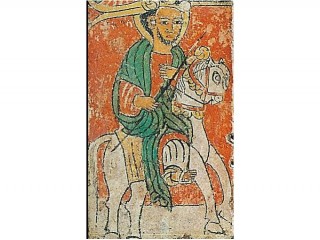
Gebre Mesqel Lalibela biography
Date of birth : -
Date of death : -
Birthplace :
Nationality :
Category : Historian personalities
Last modified : 2011-10-12
Credited as : Ethiopian king, Saint Lalibela,
Gebre Mesqel Lalibela (reigned ca. 1181-ca. 1221) was an Ethiopian king and saint to whom are attributed the famous monolithic churches of northern Ethiopia.
The life of Lalibela is clouded in myth. Almost no documents survive from his life, and we must rely largely on hagiographic literature written centuries later, after he had been canonized by the Ethiopian Church.
Lalibela seems to have been born in the town of Roha in northern Ethiopia, which was then the capital of the Zagwe dynasty. This town was later renamed Lalibela in his honor. In the late 14th or early 15th century a monk named Abba Amba wrote a biography of Lalibela. According to Amba, Lalibela was an extremely devout Christian in his youth—even to the point of being an ascetic and recluse. It was with reluctance that Lalibela married and then accepted the crown of Ethiopia, which had previously been held by his brother.
During the 12th century the Saracens were persecuting Christians in Egypt, and many of these people sought refuge under Lalibela, who was exceedingly upset with the Moslems to the north. The 18th-century Scottish traveler James Bruce wrote that Lalibela was so incensed that he actually tried to cut off the annual floodwaters to the lower Nile by diverting the source rivers in the Ethiopian highlands. There were two versions of his failure to carry out this project. The first was simply that he died; and the second was that he was warned of the dangers of invasion of famished Egyptians into what would be the even more fertile lowlands of his own country.
According to this second version, Lalibela then diverted his resources into the construction of the magnificent rock-hewn churches around Roha. Ten are said to have been built by him, the eleventh by his wife, Kebra Maskal, in his honor. The lack of contemporary sources, however, makes it difficult to assess the authenticity of these stories, and many scholars believe that some of the churches may have been the creations of other Zagwe kings.
In addition to his building of the monolithic churches, Lalibela is said to have built and generously endowed many other churches and monasteries throughout Ethiopia. It was for these pious works that he was later canonized by the Ethiopian Church, and June 6 is celebrated as his saint's day. He also left a reputation as a distinguished poet and orator.
The true nature of Lalibela's end as king may never be known, but according to Amba, after he had built the churches and divested himself of his wealth, he tired of the secular duties of rule and abdicated in favor of Naakuto Laab, who may have been his grandson. Laab was to be the last Zagwe king in Ethiopia, as he later seems to have abdicated himself in mysterious circumstances in order to allow the older Solomonic dynasty to regain the rule in Ethiopia.
The beautiful churches attributed to Lalibela are described and amply illustrated in I. Bidder, Lalibela; The Monolithic Churches of Ethiopia, translated by R. Grabham-Hostmann (1959); some historical comment is also included. Other useful general sources include E. S. Pankhurst, Ethiopia: A Cultural History (1955), and E. Ullendorff, The Ethiopians (1960; 2d ed. 1965). □
















